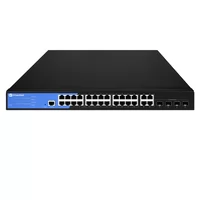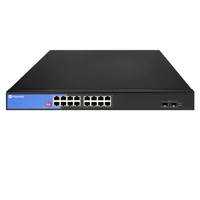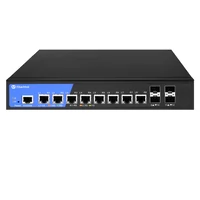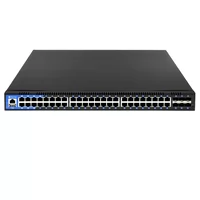The Power over Ethernet (PoE) technology allows users to receive data and power through the same network cable, saving delivery time and resources. The innovation behind this is the PoE switch. This tool is invaluable, if not essential, in today’s network setups. Understanding the switches will maximally enhance performance and cut infrastructure costs for those configuring IP cameras, wireless access points, and VoIP phones. This guide deeply examines the core features, benefits, and practical applications of the PoE switches, allowing you to make decisions with the information provided for a maximized network exploration scope. The article will give enough information to fully utilize the PoE technology by ensuring seamless powering and reducing the complexity of the infrastructure needed within your network.
What Is a PoE Switch and How Does It Work?

A Power over Ethernet (PoE) switch is a network switch that integrates both data and power over a single Ethernet cable. The provisioned devices, including IP cameras, wireless access points, and VoIP phones, can receive data and power simultaneously without needing different sockets. PoE switches work with electric power being injected through the Ethernet cables in compliance with set standards like IEEE 802.3af, 802.3at, or 802.3bt, which ensures that all devices work together without risk. This technology streamlines the network installations, reduces the amount of networking cabling, and enhances the freedom of positioning devices best suited to modern networking environments.
Understanding Power Over Ethernet Technology
Power over Ethernet (PoE) technology greatly benefits network deployments. With PoE, devices such as IP cameras, VoIP phones, and wireless access points can be powered and operated through a single cable. This allows for reduced power outlet requirements, lowers infrastructural expenses, and simplifies cabling. Additionally, users can install devices in any desired location as traditional power sources are not needed, allowing for more flexibility in device placement. Lastly, PoE uses standardized protocols that enable interoperability and safety while working reliably, making this relatively new technology essential to modern networking.
The Role of a PoE Switch in Your Network
A Power over Ethernet (PoE) Switch in contemporary networks is crucial because it delivers power and data connectivity for devices via a single Ethernet cable. This is particularly beneficial in cases where many devices, such as IP cameras, wireless access points, and VoIP phones, need to be deployed because it eliminates the need for distinct power lines to be run, simplifying the network topology. In addition, PoE switches ensure effective power distribution alongside reliable network performance, rendering them efficient and cost-saving for small and big deployments alike.
How Power and Data Are Combined in PoE Switches
A PoE switch’s combination of power and data involves a process whereby electrical power is sent with data signals over a standard Ethernet cabling. This makes it indispensable for devices that need a power supply. This is accomplished with some elements that combine the two functionalities. Depending on the PoE standard and cable type, the switch either puts power into the Ethernet cable via unused wire pairs or overlays it onto the same pairs carrying data. The receiving device, for instance, an IP camera or access point, splits power from data when receiving it; therefore, the device can be used while connected to the network. This technique allows for the effective employment of cabling infrastructure while still guaranteeing data transmission quality.
Why Should You Use a PoE Switch in Your Network?

The Benefits of PoE in Networking
About modern networking capabilities, PoE switches offer many advantages. They streamline installations by delivering data and power within a single Ethernet cable, thus minimizing the need for extra power sockets. This enhances the speed and cost-effectiveness of deploying devices like IP cameras and wireless access points. Second, PoE switches improve network scalability by allowing devices to be placed in areas devoid of nearby power sources. Lastly, power is supplied only at the required time, which ensures resource and energy efficiency and reduced spending costs, proving these switches may increase network infrastructure efficiency and energy savings. These features render PoE switches vital for effective and scalable network infrastructures.
Comparing Managed and Unmanaged PoE Switches
Fully controlled Managed PoE switches are greatly enhanced by these features and are the most suited for networks that need intense detailing. They allow the administrator to manage the traffic, improve the performance, enforce the set security measures, and perform many other functions. On the other end of the spectrum lie unmanaged PoE switches that require no configuration and can operate as plug-and-play devices. These are suitable for basic and smaller networks. The differentiation entirely depends on the necessary level of control, especially in the divide between unmanaged versus managed switch series. The more sophisticated TP-Link switches are better for expansive networks, while the unmanaged cousins are adequate in uncomplicated scenarios.
Enhancing Security with PoE and IP Cameras
Power over Ethernet (PoE) provides cost-effective and efficient connectivity for IP cameras by delivering power and data simultaneously over an Ethernet cable. This reduces the need for secondary power sources, lowering costs and simplifying installations. PoE also allows for centralized control, enabling remote monitoring and management of security systems. Using IP cameras in conjunction with advanced features such as motion detection and real-time alerts helps enhance the capability of video surveillance, effectively protecting residential and commercial spaces.
How to Choose the Right PoE Switch for Your Needs?

Factors to Consider: Gigabit, Ports, and SFP Options
While choosing a PoE switch, bear in mind the following essential issues:
- Gigabit Support: Make sure the switch provides Gigabit Ethernet, especially for IP cameras that need to stream HD videos for advanced networking applications.
- Number of Ports: The switch you select should be able to support the number of devices you need to connect. Also, think about how additional switches may be required later for growth.
- SFP Options: Choose a switch with SFP (Small Form-factor Pluggable) slots for long-range connections and fiber optic links. These ports accommodate fiber modules or uplinks as needed.
Assessing these aspects helps meet specific demands and guarantees the performance and scalability of the network systems.
Understanding Power Budget and Power per Port
In designing or optimizing a network powered via PoE (Power over Ethernet) switches, it is important to understand the power Per port, power budget, and power delivery efficiency. The power budget is the value that defines how much power a switch can supply to connected systems. For example, in modern PoE standards, switches feature the capability of providing powered devices (PDs) with either 30W or 60W/90W per port by IEEE 802.3at (PoE+) and 802.3bt (PoE++) standards, respectively.
To determine the power budget requirements, it is necessary to analyze how many systems there are for each power class and how much power they consume. For example, IP cameras typically have a power consumption of about 15-20W, whereas more advanced wireless access points or VoIP phones may need around 25-30W. For a 24-port PoE+ switch with a total budget of 410W, supporting multiple high-power devices simultaneously requires careful consideration of how power is allocated to the ports.
Moreover, power delivery efficiency is crucial. Some PoE switches can dynamically power manage active ports by providing power only to actively used ports and saving power on unused ports or lower-power devices. Furthermore, it is beneficial to consider the switch’s thermal performance, as higher power output may require enhanced cooling solutions at the optimal operational level.
Network managers can now avoid obstructions in power delivery stems and improve system reliability throughout all power-dense operational environments, such as IoT deployments, campuses, or offices. To achieve these goals, managers can focus on the power demand and ensure their switches adequately meet current needs while also trying to foresee any future requirements that need to be met.
Selecting Between 8-Port and 24-Port Gigabit PoE Switches
The selection of an 8-port or 24-port Gigabit PoE switch revolves primarily around the size and scale of the network. An 8-port switch is ideal for small networks, such as small offices or home setups with few devices. It is simple and cost-effective. Alternatively, 24-port switches are more appropriate for extensive, high-density corporate offices, campuses, or IoT systems with greater port demands and higher scalability needs.
Consider the number of devices used and how many more will be added over time. Also, power requirements must be checked to ensure the switch has sufficient PoE capacity to support connected devices. The switch selection should match the network size and growth estimate for best results.
How do you install and set up a power-over-Ethernet switch?

Connecting Your PoE Devices Safely and Efficiently
To ensure the proper and safe connection of your Power-over-Ethernet (PoE) devices, start by outlining each device’s data and power needs. Also, check the compliance of modern PoE switches with IEEE 802.3 standards, such as 802.3af (PoE), which supplies 15.4W per port, and 802.3at (PoE+), which supplies 30W per port. For powerful devices like PTZ cameras or high-end wireless access points, ensure the switch complies with IEEE 802.3bt (PoE++), which supplies 60W or up to 100W per port.
First, plug an Ethernet cable into the PoE switch and your router or core network. Ensure this switch is properly grounded to avoid any possibility of damage from electrical surges or interference. The next step is to connect the Ethernet cables from the switch to the PoE device. Use Cat5e or Cat6 cables for better power and data transfer reliability over longer distances, usually up to 100 meters. You can utilize mid-span PoE injectors or extenders for bigger networks to extend range and support connections to non-PoE switches.
Switch configuration can be done upon connecting the hardware through its web management portal or software interface. To establish segmentation, virtual local area networks (VLANs) and QoS (Quality of service) traffic policies should be created to allocate appropriate bandwidth to minimize delays on critical devices like surveillance systems. Lastly, the management application manages the switch’s ports’ PoE status and power usage to mitigate overloading while effectively managing power distribution, ensuring a secure and efficient network environment.
Troubleshooting Common PoE Switch Issues
Take into consideration the following steps for resolving issues with PoE switches.
- Device Not Powering On: Ensure the device is compatible with PoE. Also, confirm that it complies with the switch power output requirements, especially when using power-sourcing equipment. Ensure the cable is not damaged and meets the standards for Cat5e or higher, specifically when utilizing PoE Ethernet.
- Intermittent Power Delivery: Verify that the sum of the power consumed by all connected devices does not exceed the switch’s power budget. Temporarily disconnect non-essential devices to investigate the underlying issue further.
- Network Connectivity Problems: Ensure that the firmware is updated on the switch and that the port settings correspond to the device configuration. Try connecting through a different port or change the Ethernet cable to test for connectivity.
- Overheating: Examine the switch’s ventilation and remove obstructions to maximize the performance of other connected devices, including those with PoE Ethernet. Excessive heat can cause the switch to perform poorly or shut down completely.
Following these common issues allows users to restore their switches to standard functionality within minutes.
What Are the Latest Innovations in PoE Switch Technology?

Exploring Gigabit PoE and PoE Auto Recovery
Gigabit PoE technology enhances performance due to reliable data delivery and power provision over Ethernet cables. It endeavors to ensure smooth functioning and better network efficacy for modern devices heavily dependent on bandwidth, like IP cameras, wireless access points, and VoIP phones. PoE Auto Recovery is another highly significant innovation that automatically allows the switches to start unresponsive connected devices. This feature improves network infrastructure reliability and efficiency while reducing most manual overheads during connection downtime. These technologies meet the ever-increasing need for powerful device management and fast-speed connections in enterprise and industrial settings.
The Future of Power Over Ethernet in Smart Homes and Offices
Power over Ethernet (PoE) technology is well positioned to contribute significantly to developing smart homes and offices. It allows power and data to be delivered to devices such as surveillance cameras using a single cable. This technology supports many smart devices, including sophisticated lighting devices, security devices, and IoT sensors, which results in a higher installation cost efficiency. New advancements in PoE standards, like IEEE 802.3bt, enable higher power delivery, which makes it possible to accommodate more powerful and energy-expensive devices like smart displays and network appliances. The effortless integration and scalability that facilitates PoE makes it a strategic backbone for the sophisticated demand in connected environments, enabling efficient, reliable, and robust residential and commercial IoT ecosystems.
Advancements in Managed PoE Switch Capabilities
Managed PoE switches have evolved considerably to match contemporary network infrastructure needs. Real-time per-device power monitoring and enhanced energy consumption management capabilities are notable features. The switches now support more significant power budgets accommodating devices that need up to 90W per port as specified under IEEE 802.3bt. Segmented and controlled device connectivity is further ensured by implementing sophisticated security protocols like NAC and VLANs. Furthermore, intelligent management tools provide simple dashboards for device performance checks, remote configurations, performance troubleshooting, and many more. All these factors reinforce managed PoE switches as the backbone of a flexible and robust network.
Frequently Asked Questions (FAQs)
Q: What is a PoE Switch, and how does it serve as a network switch?
A: A PoE switch is a network switch that facilitates data sending and receiving and powers devices such as IP cameras and wireless access points through Ethernet cables. This allows powered devices to be located where there may not be power outlets, simplifying installation for PoE Ethernet devices.
Q: How do I select a managed and unmanaged switch for my PoE setup?
A: Managed switches are more complex and offer greater control over network traffic, while unmanaged switches are simple and require no configuration. If more control over the network devices is essential, opt for a managed switch, though simpler setups may find unmanaged switches more than adequate.
Q: What must I think about regarding the PoE budget when deciding what switch to purchase?
A: The PoE budget refers explicitly to the maximum power a PoE switch can provide to connected devices. Always confirm that the switch you pick has enough watts of PoE to cover all network devices without going beyond the power limits of the switch.
Q: What are the benefits of PoE switches in a network infrastructure?
A: PoE switches enhance the simplicity of a network infrastructure because data and power are received through one ethernet cable. They also bring cost-effective savings because power outlets are unnecessary and increase flexibility regarding where devices can be placed.
Q: How many ethernet ports are typically available on PoE switches?
A: PoE switches offer a range of ethernet ports, including 8-port, 16-port, and 24-port configurations, to accommodate network systems’ varying sizes and scopes.
Q: What is the significance of gigabit ethernet in PoE switches?
A: Considerable amounts of data flow through surveillance cameras, which necessitate their space efficiency. Therefore, Gigabit Ethernet-in PoE switches make high-speed data transfer possible with added support for more bandwidth-intensity applications. Also, network performance must be maintained when many devices are connected.
Q: Can PoE switch support devices that require high-power PoE, such as 90W PoE?
A: Certain PoE switches can meet high-power PoE standards like 90W, where more demanding devices, such as advanced security IP cameras and high-end access points, can be used.
Q: What are the advantages of using an 8-port PoE switch?
A: The 8-port PoE switch is well-suited for small to medium network configurations. It offers enough connectivity and power for several devices without requiring the construction of a complex network infrastructure.
Q: Are PoE switches compatible with all network devices?
A: PoE switches work with network devices that are geared to accept power over Ethernet cables. For non-PoE-enabled devices, additional equipment, such as PoE splitters or a power supply, will be required for proper compatibility.
Reference Sources
1. PoE Switch Transfers Security Controls
- Author: N/A
- Journal: New Electronics
- Publishing Date: March 1, 2023
- Summary: The discussion concerns the environmental protective measures, and easy installation Microchip’s PDS-204GCO comes with. The article also discusses additional security features that enhance the PoE switch’s functionality in networking environments (“PoE Switch Transfers Security Controls,” 2023).
2. Create a remote control system to adjust home and office equipment using a PoE switch with an integrated data communication facility, including support for gigabit Ethernet unmanaged connections.
- Authors: M. Alamgir, A. Chowdhury, Kazi F. Ahmmed
- Journal: International Journal of Control and Automation
- Publication Date: January 31, 2015
- Summary: This project aimed to design and build a system based on a Power over Ethernet (PoE) switch that can control various electrical appliances, such as lights and fans, while allowing for data communication. The system is helpful for elderly and physically disabled people because control can be exercised through Wi-Fi, and the internet facilitates easier communication, as emphasized by the author’s security provision through password-sensitive devices (Alamgir et al., 2015, pp. 103–110).
3. A remote power management system designed to improve the service delivery of Bangladeshi ISPs using a PoE switch-based architecture
- Authors: M. Alamgir, Md. Saidul Islam
- Conference: 2015 18th International Conference on Computer and Information Technology (ICCIT)
- Publication Date: December 1, 2015
- Summary: This research presents a remote power control system based on a PoE switch that enables network administrators to turn powered network devices on and off from a remote location. The system aims to reduce the traveler’s time and cost for Bangladeshi Internet Service Providers (ISPs), which improves service (Alamgir & Islam, 2015, pp. 23-26).
Related Products:
-
 S2100-24T4TS, 24-Port Ethernet Switch L2+, 24x 10/100/1000BASE-T RJ45, with 4x 1G RJ45/SFP Combo Uplinks
$148.00
S2100-24T4TS, 24-Port Ethernet Switch L2+, 24x 10/100/1000BASE-T RJ45, with 4x 1G RJ45/SFP Combo Uplinks
$148.00
-
 S2100-16T2S-P, 16-Port Ethernet Switch L2+, PoE+ Switch, 16x 10/100/1000BASE-T RJ45, with 2x 1G SFP Uplinks
$230.00
S2100-16T2S-P, 16-Port Ethernet Switch L2+, PoE+ Switch, 16x 10/100/1000BASE-T RJ45, with 2x 1G SFP Uplinks
$230.00
-
 S3100-8T4X, 8-Port Ethernet Switch L3, 8x 10/100/1000/2500/10G BASE-T RJ45 Ports, with 4x 1G/10G SFP+ Uplinks
$398.00
S3100-8T4X, 8-Port Ethernet Switch L3, 8x 10/100/1000/2500/10G BASE-T RJ45 Ports, with 4x 1G/10G SFP+ Uplinks
$398.00
-
 S3100-48T6X-P, 48-Port Ethernet Switch L3, PoE+ Switch, 48x 10/100/1000BASE-T RJ45, with 6x 1G/10G SFP+ Uplinks
$734.00
S3100-48T6X-P, 48-Port Ethernet Switch L3, PoE+ Switch, 48x 10/100/1000BASE-T RJ45, with 6x 1G/10G SFP+ Uplinks
$734.00
Related posts:
- Layer 3 Switch vs Router: Key Differences and Cisco Insights Explained
- Unlocking the Power of Infiniband: A Deep Dive into Copper Cables and Direct-Attach Solutions
- Exploring DWDM Equipment: Key Components and Benefits in Optical Networks
- Unleash Your Network’s Potential: The Ultimate Guide to Gigabit Ethernet Switches
